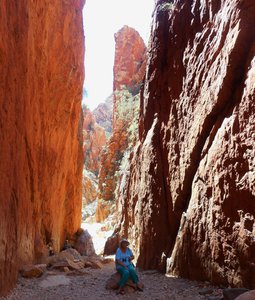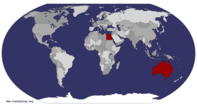Advertisement
Published: October 7th 2014

 Standley Chasm
Standley Chasm
The best time to see this chasm is midday, when both sides are lit. This was about 12.40pm so only one side is gleaming but it still looks amazing. The wall rise 80 m above the floor and have been created by the river surging through the narrow gap and wearing out the sandstone over millions of years.We were a little later leaving than we’d meant to be as I needed to iron a couple of items before we left.
Our first stop was Simpson’s Gap, 25km out of Alice along the West Macdonnell Ranges. We parked the car and set off on the walk beside and along the river bed to the Gap. On the way, we passed an area of rocks piled up at the base of the mountain wall. A Ranger was just finishing his talk when we arrived and he pointed out a Black Footed Rock Wallaby, like those we fed at the Heavitree Homestead. It was sunning itself on top of one of the high up rocks but as we watched, decided there was too much activity and took off, hopping easily and quickly across the jagged surface, because they have rough foot pads which grip the rocks. We were told that there was a group of about 20 animals living in those rocks but we couldn’t see any. They hide well. The Ranger said that the numbers were in decline in the region due to feral predators. We’re losing so many little animals.
We continued along the path to the

 Along the Path to Standley Chasm
Along the Path to Standley Chasm
Cycads and ferns grow along the dry river bed and create this lovely frame for the glowing red walls that are catching the sunlight beyond.Gap. There was a large rather brackish pool at the end, all that’s left of the river at this time of year, with a grandfather and two young boys who were exploring the sand bar along one edge. One came to show me something he’d found – “It’s a frog’s heart”. It wasn’t – it was a half dead pink heart-shaped flower from one of the plants growing all around the area. He was most disappointed.
The Gap looked very nice, with the light reflecting in the water, especially as we could stand in the shade on one side to enjoy the view. When we got back to the car park, there was a pair of White-Throated Honey-eaters pecking away at the mirrors, cheeky things.
We set off again another 25km down the Larapinta Drive to Standley Chasm, named for the first non-Aboriginal woman to visit there. She had been the first school teacher, appointed in 1914 and later becoming matron of a school for Aboriginal children.
At the Kiosk, we bought the tickets to enter ($8 each for Seniors) and walked along the 1.2km nature trail to the Chasm. We followed a creek bed which had

 Ellery Creek Big Hole and Ellery Gap
Ellery Creek Big Hole and Ellery Gap
This is one of the largest permanent waterholes in the West Macdonnell Ranges and is a popular picnic spot. The water is deep once past the beach and at this time of year is cold. All the people in the water here were out before we left, about ten minutes later. One young lady went in, counted to ten and got straight out!a few spring-fed pools that are always there and so attract birds and other small animals. There were also lots of wildflowers, gum trees and areas with Cycad Palms climbing up the steep rocky sides. It was a lovely walk, mostly in shade and with lots of wonderful opportunities for photos. You had to watch where you put your feet as it was a bit rough on the track but then it was a wonderful surprise when you looked up again and the scene had changed again. Beautiful.
At the end of the walk was a deep cleft with 80 metre walls rising from it. The sun was shining strongly on one face and turning it a marvellous bright red. If you get there at midday both faces are lit up but we were a little late. We could see more of the range through the gap, although it was blocked off by a large pile of rocks and had a sign to stop you going further. As we sat and admired the view the sunlight crept up the face, taking away the brightness of the colour as it went. By one o’clock the chasm was back in the

 Ochre Pits
Ochre Pits
Ochre has been collected from here for thousands of years by the local Aboriginal people for use in their ceremonies, dances and decorations, because of its wide range of colours. They were originally laid down horizontally but earth upheaval about 300 million years ago has made them vertical then erosion has split the layers to reveal the colours.shade, still lovely but less spectacular. I’m so glad we got there in time to see it alight.
Back at the kiosk we had a refreshing iced coffee each and then found a picnic table in the shade to have some lunch.
Next we turned on to Namatjira Drive, named after the Aboriginal artist Albert Namatjira from the area who painted the Ranges so well. We arrived at Ellery Creek Big Hole, one of the largest permanent waterholes in the region, and saw several groups of people there, with the adults sitting on the beach area and the kids in the water. A group of young tourists arrived and went into the water, one lady walked in up to her middle, counted to ten and then got straight back out again. She said the water was very cold. I took off my shoes and had a paddle – it was cold at first but was lovely and refreshing to stand in as I’d been getting rather too hot. The hole was quite long and very deep in the middle going back to the Ellery Gap, where Ellery Creek passes through the ranges. The walls were quite steep but

 Point Howard Lookout
Point Howard Lookout
These strange dark red outcrops of rock appeared at regular intervals all along the Namatjira Drive. It looked like an old "Hadrian's Wall" that was disintegrating with age! The green blobs all over the hillside are Weeping Spinifex, which has silica crystals in its spiky leaves, making them stiff like sandpaper.fairly wide, allowing a nice area for people to come and spend an afternoon.
We stayed there 10 minutes and by then everyone else had come out of the water, too, even one lady who’d swum to the Gap had climbed out and was sitting on some rocks halfway back to the beach. It really was cold!
Back on the road we noticed Neil Harvey Lookout and Rest Area so we went up to have a look. There was a lovely view across the ranges and some people had already set up to have a free camp, allowed for 24 hours. I’d love to do that but we’d have a bit of trouble getting the rig up the steep slope.
Our last stop was at the Ochre Pits. These were even more colourful than the red soils and ranges that we’d been seeing all day. The face showed all colours from white to strong yellow, all shades of orange and pink and even deep red, neatly laid out in vertical stripes. No wonder the local Aboriginal people had valued them so much for their ceremonies and artwork, and still do. There was a sign forbidding touching or
removing any rocks, with a heavy fine for offenders.
The colours are produced by red iron oxide in various amounts, mixing with other elements like the white kaolin or the black haematite to create the wide variety. I walked back to the viewing platform while Barry continued videoing and joined a young man sitting on the bench. He was listening to a pretty birdsong but I couldn’t see the bird. He had a large pair of binoculars and a camera with an enormous zoom lens on it so I guessed he was a serious birdwatcher. The little bird then left the tree and zoomed past us. All I saw was it was little, fast and brown. I asked my neighbour what it was and was told a Rufous Whistler. This was one in the Birds of the Top End Book, so I can mark him off. I’d never have known that’s what I’d seen without being told. I don’t know how they do it.
Barry arrived and we made our way back to the car and started to leave the car park, when Barry noticed a lizard standing right ahead of us with its tail curled over its

 A Black Headed Goanna (I Think)
A Black Headed Goanna (I Think)
This lizard was crossing the exit of the car park as we left the Ochre pits. It had its tail curled over its back like a scorpion when we first saw it, then it disappeared quickly into the spinifex.back like a scorpion. We stopped and after a short time it scurried off into the undergrowth next to the exit road. I’m not sure what it was but I’ve never seen a lizard hold its tail like that before so I’m calling it the Scorpion Lizard. We then resumed our journey home. We had planned to go to Glen Helen Gorge and Ormiston Gorge as well but they were still a long way off, the afternoon was rapidly coming to a close and Barry was getting tired, with the drive back still to do. We decided to put them on our to-do list for when we come back up next year. I’d like to see some of the East Macdonnell Ranges features then, too.
On the way home the ranges were looking even brighter as the sun was getting lower and the light shone on the faces. At regular intervals all along the sides of the road were strange rock formations that looked like parts of a broken down “Hadrian’s Wall”, only made of dark red rock. We could also see lots of round humps of bright green Weeping Spinifex. We’d seen them earlier along some of the river banks and I’d read on a board that they contain silica crystals that make the spiky leaves stiff like sandpaper. They looked wonderful against the red soil and dark rocks.
We stopped at one more lookout, Point Howard, on the way back. This was also up a steep slope and had lovely views across a Gap and of the “Wall” structures I’d been seeing. Barry found a small discrete memorial plaque to someone attached to one of the red round rocks near the edge, obviously for someone who’d loved the view.
We got back to Alice Springs just as the sun was setting so we went up to Anzac Hill Lookout to see the city at dusk. A small hill we could see from the lookout had caught the rays and gleamed red for a few minutes then became dull again as the sun sank below the horizon leaving the sky itself glowing a lovely pinky-orange colour. What a nice colourful end to our colour-filled day.
Advertisement
Tot: 0.15s; Tpl: 0.018s; cc: 10; qc: 50; dbt: 0.1093s; 1; m:domysql w:travelblog (10.17.0.13); sld: 1;
; mem: 1.1mb











Snap Shot Stacey
Snap Shot Stacey
Wow! Fantastic photo and such a beautiful spot. :D